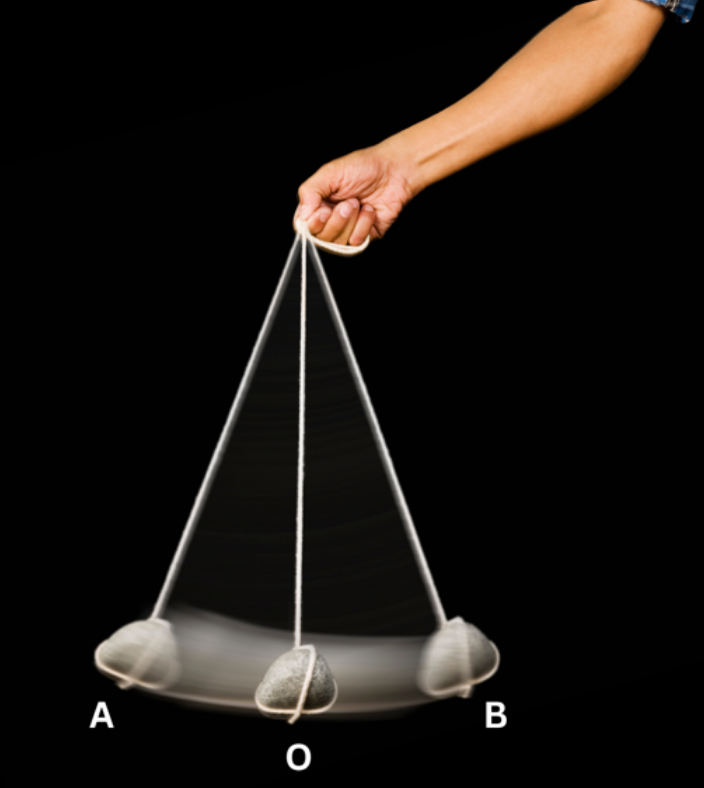2. Complete Activity 9.2 (Page 95). Set up a simple pendulum as shown in Fig. 9.4 (a) with a thread or string of length nearly one metre. Switch off any fans nearby. Let the bob of the pendulum come to rest at its mean position. Mark the mean position of the bob on the floor below it or on the wall behind it.
To measure the time period of the pendulum we will need a stopwatch. However, if a stopwatch is not available, a table clock or a wristwatch can be used.
To set the pendulum in motion, gently hold the bob and move it slightly to one side. Make sure that the string attached to the bob is taut while you displace it. Now release the bob from its displaced position. Remember that the bob is not to be pushed when it is released. Note the time on the clock when the bob is at its mean position. Instead of the mean position you may note the time when the bob is at one of its extreme positions. Measure the time the pendulum takes to complete 20 oscillations. Record your observations in Table 9.2. The first observation shown is just a sample. Your observations could be different from this. Repeat this activity a few times and record your observations. By dividing the time taken for 20 oscillations by 20, get the time taken for one oscillation, or the time period of the pendulum.
Is the time period of your pendulum nearly the same in all cases?
Answer:
The Activity 9.2 can be carried out in the following way:
Aim: To determine if the time period of the pendulum remains the same.
Materials Required: Rigid stand, simple metallic ball or a piece of stone, thread, stopwatch or table clock.
Procedure:
(i) Take a one-metre long thread and attach a small metallic ball or a piece of stone to its end to make your own simple pendulum. The metallic ball or the stone is called the bob of the pendulum.
(ii) Suspend the pendulum from a rigid stand or your hand, switch off the nearby fans and let it come to rest at its mean position. Mark the mean position of the bob on the floor or the wall behind it.
(iii) While keeping the thread taut take the bob of the pendulum, gently move it one side and release it. Do not push the bob when releasing it.
(iv) Note the time on the stopwatch or clock when the bob is at its mean position or at one of its extreme positions. It might be easier to choose one of the extreme positions as a starting point.
(v) Measure the time the pendulum takes to complete 20 oscillations and record your observations in Table 9.2. Repeat this activity a few times and record your observations
(vi) In each case, find the time period of the pendulum (time taken for one oscillation) by dividing the time taken for 20 oscillations by 20.

Observations: The completed Table 9.2 is shown below:
Table 9.2 Time period of a simple pendulum
Length of the string = constant
| S. No. | Time taken for 20 oscillations (s) | Time period (s) |
| 1. | 40 | 2 |
| 2. | 40 | 2 |
| 3. | 39 | 1.95 |
| 4. | 40 | 2 |
Conclusions:
- The time period of the pendulum remains the same in all cases.
- A slight displacement in the initial displacement does not affect the time period of your pendulum.
“Set up a simple pendulum as shown in Fig. 9.4 (a) with a thread or string of length nearly one metre. Switch off any fans nearby. Let the bob of the pendulum come to rest at its mean position. Mark the mean position of the bob on the floor below it or on the wall behind it.
To measure the time period of the pendulum we will need a stopwatch. However, if a stopwatch is not available, a table clock or a wristwatch can be used.
To set the pendulum in motion, gently hold the bob and move it slightly to one side. Make sure that the string attached to the bob is taut while you displace it. Now release the bob from its displaced position. Remember that the bob is not to be pushed when it is released. Note the time on the clock when the bob is at its mean position. Instead of the mean position you may note the time when the bob is at one of its extreme positions. Measure the time the pendulum takes to complete 20 oscillations. Record your observations in Table 9.2. The first observation shown is just a sample. Your observations could be different from this. Repeat this activity a few times and record your observations. By dividing the time taken for 20 oscillations by 20, get the time taken for one oscillation, or the time period of the pendulum.
Is the time period of your pendulum nearly the same in all cases?” – Solved.
Related Links:
Solution to Extended Learning Problem 1
Solution to Extended Learning Problem 2
Solution to Extended Learning Problem 3
Solution to Extended Learning Problem 4
Solution to Activity 9.1
Solution to Activity 9.2
Solution to Activity 9.3


